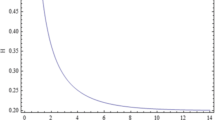Abstract
The paper deals with a spatially homogeneous and anisotropic Bianchi type-I universe filled with two minimally interacting fluids; matter and holographic dark energy components. The nature of the holographic dark energy for Bianchi type-I space time is discussed. An exact solution to Einstein’s field equations in Bianchi type-I line element is obtained using the assumption of linearly varying deceleration parameter. Under the suitable condition, it is observed that the anisotropy parameter of the universe approaches to zero for large cosmic time and the coincidence parameter increases with increasing time. We established a correspondence between the holographic dark energy models with the generalised Chaplygin gas dark energy model. We also reconstructed the potential and dynamics of the scalar field which describes the Chaplygin cosmology. Solution of the field equations shows that a big rip type future singularity will occur for this model. It has been observed that the solutions are compatible with the results of recent observations.







Similar content being viewed by others
References
Ade, P.A.R., et al.: (2013). arXiv:1303.5076
Adhav, K.S.: Int. J. Math. Arch. 2, 2149 (2011)
Adhav, K.S., et al.: Astrophys. Space Sci. 332, 497 (2012)
Akarsu, O., Dereli, T.: Int. J. Theor. Phys. (2011). doi:10.1007/s10773-011-0941-5
Akarsu, O., Kilinc, C.B.: Astrophys. Space Sci. 326, 315 (2010)
Akarsu, O., Kilinc, C.B.: Gen. Relativ. Gravit. 42, 763 (2012)
Armendariz, C., et al.: Phys. Rev. D 63, 103510 (2001)
Bagla, J.S., et al.: Phys. Rev. D 67, 063504 (2003)
Barreiro, T., et al.: Phys. Rev. D 61, 127301 (2000)
Bennett, C.L., et al.: Astrophys. J. Suppl. Ser. 148, 1 (2003)
Bento, M.C., et al.: Phys. Rev. D 70, 083519 (2004)
Berman, M.S.: Nuovo Cimento B 74, 182 (1983)
Blandford, R.D., et al.: (2004). arXiv:astro-ph/0408279
Caldwell, R.R.: Phys. Rev. Lett. 91, 071301 (2003)
Capozziello, S., et al.: Phys. Lett. B 632, 597 (2006)
Cataldo, M., et al.: Phys. Lett. B 619, 5 (2005)
Chiba, T., Nakamura, T.: Prog. Theor. Phys. 100, 1077 (1998)
Copeland, E.J., Sami, M., Tsujikawa, S.: Int. J. Mod. Phys. D 15, 1753 (2006)
Fischler, W., Susskind, L.: (1998). arXiv:hep-th/9806039
Gasperini, M., et al.: Phys. Rev. D 65, 023508 (2002)
Gonzalez-Diaz, P.F.: Phys. Lett. B 586, 1 (2004)
Granda, L.N., Oliveros, A.: Phys. Lett. B 669, 275 (2008)
Granda, L.N., Oliveros, A.: Phys. Lett. B 671, 199 (2009)
Hsu, S.D.H.: Phys. Lett. B 594, 13 (2004)
Katore, S.D., et al.: Astrophys. Space Sci. 337, 393 (2012)
Knop, R.K., et al.: Astrophys. J. 598, 102 (2003)
Kumar, S., Akarsu, O.: (2012). arXiv:1110.2408
Kumar, S., Yadav, A.K.: Mod. Phys. Lett. A 26, 647 (2011)
Leon, G., et al.: Phys. Lett. B 693, 1 (2010)
Li, M.: Phys. Lett. B 603, 1 (2004)
Naidu, R.L., et al.: Astrophys. Space Sci. 338, 333 (2012)
Nojiri, S., et al.: Phys. Rev. D 71, 063004 (2005)
Nojiri, S., et al.: Phys. Lett. B 686, 44 (2010)
Overduin, J.M., et al.: Phys. Rev. D 58, 043506 (1998)
Padmanabhan, T., Choudhury, T.R.: Phys. Rev. D 66, 081301 (2002)
Perlmutter, S., et al.: Nature (London) 391, 51 (1998)
Pradhan, A., et al.: (2010). arXiv:1010.1121
Pradhan, A., et al.: Astrophys. Space Sci. 337, 401 (2012)
Riess, A.G., et al.: Astron. J. 116, 1009 (1998)
Saha, B., Yadav, A.K.: Astrophys. Space Sci. 341, 651 (2012)
Sahni, V.: (2002). arXiv:astro-ph/0211084
Sarkar, S., Mahanta, C.R.: Int. J. Theor. Phys. 52, 1482 (2013a)
Sarkar, S., Mahanta, C.R.: Gen. Relativ. Gravit. 45, 53 (2013b)
Sen, A.: J. High Energy Phys. 0207, 065 (2002)
Setare, M.R.: Phys. Lett. B 644, 99 (2007a)
Setare, M.R.: Phys. Lett. B 653, 116 (2007b)
Setare, M.R.: Eur. Phys. J. C 50, 991 (2007c)
Setare, M.R.: (2007d). arXiv:0704.3679
Setare, M.R.: Phys. Lett. B 654, 1 (2007e)
Setare, M.R.: Eur. Phys. J. C 52, 689 (2007f)
Setare, M.R., Vanegas, E.C.: Int. J. Mod. Phys. D 18, 147 (2009)
Singh, T., Chaubey, R.: Pramāna 71, 447 (2008)
’t Hooft, G.: (2009). arXiv:gr-qc/9310026
Tegmark, M., et al.: Astrophys. J. 606, 702 (2004)
Visser, M.: Class. Quantum Gravity 21, 2603 (2004)
Visser, M.: Gen. Relativ. Gravit. 37, 1541 (2005)
Yadav, A.K., Saha, B.: Astrophys. Space Sci. 337, 759 (2012)
Yadav, A.K., Yadav, L.: Int. J. Theor. Phys. (2010a). doi:10.1007/s10773-010-0510-3
Yadav, A.K., Rahaman, F., Ray, S.: (2010b). arXiv:1006.5412
Zimdahl, W., et al.: Phys. Rev. D 64, 063501 (2001)
Author information
Authors and Affiliations
Corresponding author
Rights and permissions
About this article
Cite this article
Sarkar, S. Holographic dark energy model with linearly varying deceleration parameter and generalised Chaplygin gas dark energy model in Bianchi type-I universe. Astrophys Space Sci 349, 985–993 (2014). https://doi.org/10.1007/s10509-013-1684-y
Received:
Accepted:
Published:
Issue Date:
DOI: https://doi.org/10.1007/s10509-013-1684-y




